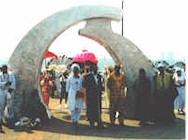A 12 ft. high,17 ft. wide, 1,100 lb., aluminum arch structure constructed in two parts—symbolizing the past joining with the future—was unveiled July 3 during ceremonies at Riverbank State Park in Harlem as part of the Middle Passage Monument Project. "The Atlantic Ocean is the largest unmarked grave site. This is a gravestone for the million of bones on the ocean floor," said Wayne James, explaining why the monumnet was hoisted aboard the "Young America," a replica of an 18th century slave ship, to be taken and lowered onto the Atlantic Ocean’s floor at 427 kilometers (265 miles) due east of New York Harbor. Each kilometer also represents one of the bodies unearthed by construction crews in 1991 from an ancient African burial ground in lower Manhattan. "As the new millennium comes in, we as Black people have to use slavery as a means of strengthening us. In the context of our vast, rich African history, slavery can be intellectually reduced to a despicable footnote. I hope we can use this event as an opportunity to begin healing from the atrocities of slavery," said Mr. James, a native of St. Croix. The dedication ceremony drew over 1,200 people, including international dignitaries and representatives who came to witness the historic event. "This kind of event is long overdue," said Father Martin Carter of Our Lady of Victory Roman Catholic Church in Brooklyn. "I grew up in a family of Garveyites. An event like today was always the hope of my family. We as Blacks have a sense of denial, we don’t want to remember. If we ever come together in meaningful unity, we can have whatever we want in this country," he said. The dedication began with an enormous funeral procession complete with wreath, parasol and fan bearers, drummers and interfaith clergy. It was followed by a Tibetan monk striking a chime 400 times—one chime for every year of slavery. A parade of religious leaders then performed funeral ceremonies and blessed the monument. "We must remember that there is a God, and we must unite to ensure that the Holocaust will never be repeated. This day is the beginning. Finally, a proper memorial is given to the millions of our ancestors who were slain during the middle passage," said Min. Benjamin Muhammad, East Coast Regional Representative of the Nation of Islam, to loud applause. "This is a very inspirational day and very enthusiastic. We still remember our culture and we’re still passing this rich culture through our generations," said Nana Ataa Pokuaa, of Ghana. For the next six years on July 3, replicas of the monument will be placed on land in Africa, the Caribbean, Central America, Europe, North and South America. Later in July, another replica slave ship will set sail on a six-month voyage retracing, in reverse, the triangular trade route used by slave ships. The voyage will take Mr. James and his crew to Bermuda, then the Azores, Spain, Portugal and then finally to the African nations of Senegal, Ghana, and Benin. The ship’s re-entry in Africa is a symbolic re-entry through the "Door Of No Return"—which Africans were forced to take before they were loaded on slave ships. United Nations Secretary General Kofi Annan is in the process of having the ocean site designated as a sacred burial site for Blacks. In the two weeks leading up to the dedication ceremony, a series of events were held in honor of African ancesters. At a July 2 candlelight vigil, the names of ancestors were read and placed into a water-filled glass urn. The urn was secured and placed alongside the monument at the ocean’s bottom. During the vigil, Cynthia Gaston, of Washington, D.C., was rushed to the hospital for high blood pressure. She checked herself out and returned in time for the end of the observance. The vigil was "too important to miss, I wanted to at least light a candle," she said. The Middle Passage Monument Project has been a labor of love for almost two years for Wayne James, who has been a virtual one-man show. He created the Homebound Foundation in Washington, D.C., which sponsored the project and promotes dialogue between Black organizations. Mr. James also spent 20 hours a day working on the project. His profession as a lawyer has been virtually put on hold. "I now know the difference between a career and a calling," Mr. James said. "There is a whole energy to this project that has nothing to do with me, it just compels me to do it. It has been by far the most fulfilling thing I’ve ever done," he said. The project has had its fair share of setbacks, pitfalls and changes. The ship first slated to be used for the voyage was sold a week before the dedication. Mr. James found a replacement just 48 hours before the ceremony. His original plan was to sail from New York to Bermuda and on the return trip, at the designated point, release the monument. However, realizing most people would not be able to participate, Mr. James decided a land ceremony would be best. To raise funds, the foundation plans to release a CD featuring a well-known international artist. While on the voyage across the Atlantic, Mr. James hopes to write a series of essays on issues important to Black people for publication in the year 2000. (Saeed Shabazz and Rafika Soaries contributed to this report.) |
 NEW YORK—From
Louisiana to Liberia, Boston to Benin, Blacks from across America and throughout the
Diaspora converged in New York City to pay homage to the millions who perished during the
journey from Africa to the Americas in the TransAtlantic slave trade.
NEW YORK—From
Louisiana to Liberia, Boston to Benin, Blacks from across America and throughout the
Diaspora converged in New York City to pay homage to the millions who perished during the
journey from Africa to the Americas in the TransAtlantic slave trade.